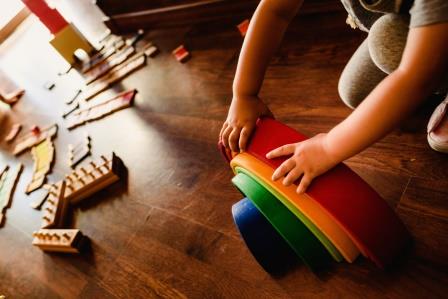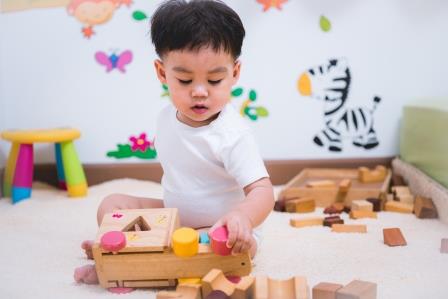By Jen Johnston, CHHC, senior marketing services account manager, for the Culture of Wellness blog series
In 2011, I was a young 30-something, excited and anxious about bringing my first child earthside. I was exploring birthing options, researching organic mattresses, and already leaning toward a more natural lifestyle, but boy was I in for a shock when I started researching toys.
A few weeks ago I kicked off this blog series by stating that I believed everything was wellness and wellness was everywhere. Today my goal is to outline that toys fall into that same category; at least certain toys do!
During my mom’s parenting years, there was no such thing as “healthier” toys — just safe and unsafe. (If you want to know what I mean by unsafe, just look up Jarts, a lawn dart toy popular in the 70s and 80s that was responsible for a number of deaths.) But by the time I was becoming a parent, I had all of these things to consider when choosing healthy toys:
Lead
Parents are right to worry about lead in toys. Thirty percent of the childhood lead poison cases followed by the CDC are not caused by paint, which was banned in 1978. China manufactures 80% of the toys sold in the U.S., and of the four million voluntary recalls in a particular 14 month period due to excessive lead in toys, the majority of them were produced in China. It wasn’t only happening to the smaller brands either — even Mattel issued a massive recall in 2007.
While lead toys haven’t been an overly huge news topic, mothers like Tamara Rubin of Lead Safe Mama, and other online influencers have brought this issue to the forefront of wellness conversations in a grassroots way. Because of lead concerns, many consumers are beginning to seek out toys that are made in the U.S. or Europe which they perceive as safer.
Plastic toys from China
As I continued to do my research as a mama-to-be, I discovered any toys made in China were seen by those immersed in wellness culture as less healthy because the quality control was perceived as not as strict. According to What to Expect, toy stores took note and began offering lists of “toys not made in China,” and online groups popped up such as Eco-friendly USA run by Jessica Brandt which advocate for safer and more eco-friendly toy brands that are manufactured in the U.S.
PVC
My research showed PVC was also considered a wellness no-no. I quickly learned that most soft plastic toys are made from PVC, unless it says otherwise on the package. PVC, I read, contained harmful chemicals including carcinogens and phthalates. Definitely not something in line with my wellness ideals.
BPA
Even if I found a PVC-free plastic item, there was BPA to be concerned about. Web MD states that the U.S. Department of Health says toys generally don’t contain BPA. Of course, that doesn’t seem to matter to parents in the culture of wellness. We were scared out of our minds by all the baby products that used to contain it — from sippy cups to infant formula liners. If a toy brand states its product is BPA-free, even if the others probably don’t have BPA either, there is a better chance that wellness-conscious parents will buy it. See how “free from” ideas from the food and healthcare products space apply here too?
So, what kind of toys were left for me and other wellness enthusiasts to buy? Toys that appeal to those living a “wellness lifestyle” include:
Wood or bamboo toys
I couldn’t talk about wooden toys without talking about Melissa & Doug. While this company has been around since the 1980s, it wasn’t until the interest in wooden toys picked up steam (fueled, in my opinion, by the culture of wellness) that the company took off. In the years since I had my first baby I’ve seen Melissa & Doug penetrate stores such as Target, Walmart (their largest importer), and even my local independent pharmacy.
Being manufactured in China, the products have not been without controversy among natural lifestyle purists, however, Melissa & Doug truly brought wooden toys into the mainstream. What was once a niche brand can be bought virtually everywhere. Other popular brands include Plan Toys (Thailand) made from sustainable rubberwood, Hape (German) made from bamboo, and Janod (French), made from wood and cardboard.
Organic cotton, wool, or hemp toys
While cloth dolls and toys were being touted as “better” by the wellness gurus, conventional cotton had this reputation as being sprayed with chemicals, therefore I looked for brands using natural and organic materials. Burt’s Bees® has gotten into the toy game and now offers organic cotton rattles that are available in stores such as buybuy Baby® alongside Apple Park™ Organic Farm Buddies™.
I have noticed that big box retailers have primarily stuck to organic cotton baby toys, not toys for older children. For these and for a greater selection, consumers are turning to niche online retailers such as Nova Natural and Mighty Nest. However, these products are even beginning to show up in greater numbers on Amazon.
Recycled toys
While they are made of plastic, popular eco-brand Green Toys has made their mark in the culture of wellness. They have done a great job appealing to the wellness crowd. This brand manufactures their toys in the U.S., and its products are made from recycled milk bottles. They don’t use glue, metal, screws, or paint, and surpass standards for BPA and phthalates.
Their packaging is also made from recycled materials, and they tell a story of a tightly controlled supply chain that provides local jobs and reduces greenhouse gases, energy, and transportation costs. Green Toys are frequently recommended by online influencers in the natural space and have become available everywhere from Whole Foods to Barnes & Noble, from my neighborhood independent toy store to Sam’s Club.
I mentioned earlier that there are niche toy retailers appealing to the consumer looking for a safer experience for their child. MightyNest says they strive to “take the guess work out” of finding healthy, safe natural toys for kids. All of the toys they sell are free from BPA, Phthalate, PVC, formaldehyde, and lead.
But as larger retailers such as Target continue to expand their chemical policies (I’ll write about this in a future post), don’t be surprised to see “better-for-you” toys showing up in more retail outlets.
I want to stress, however, that “better-for-you” extends beyond the materials used to make the toys. Educational approaches such as Montessori, Waldorf, and Reggio Emilia factor in as they are often seen in natural wellness circles as superior. Each educational philosophy comes with a particular set of toys meant to enrich children and advance their mental, social, and emotional health. Therefore, I’ve seen these toys bleed over into the culture of wellness.
In a similar way, the concept of toy minimalism also bleeds over into the culture of wellness. Owning less toys (and encouraging more creativity with a smaller amount of toys) is being promoted by some online influencers as better for a child’s and the parents’ collective wellbeing. Toy makers should be wise and watch this small but growing trend.
Of a particular humorous note, I checked out the Google Trends listing for “own less toys” and it always spikes around Christmas, indicating parents are more overwhelmed with the amount of toys in their homes at the onslaught of the gift-giving season, but by the spring when the searches clearly dip, they have other things on their mind!
I will let you in on my little secret — while I do have wooden, eco-friendly, recycled, cotton, wool, and hemp toys, my kids also have soft plastic, PVC-ridden toys made in China, which quite possibly also contain lead. It’s a challenge to get away from these toys, even for those striving to live a more natural lifestyle. I am probably one of those people searching “own less toys” around the holidays because that’s when we find more and more mainstream toys entering our home, but like many people in the wellness culture, I realize I can’t be perfect in every area of my life.
While you will find a few “safer toys” purists, my gut says there are many more people just like me — people who strive to “do better” but find it challenging. So what does this mean for the toy industry? I believe there is a wellness trend here to watch, but it is a slower build than other categories like beauty or even cleaning products.
I challenge retailers to consider what they can do with their selection to promote their toy offerings as healthier or safer as a way to get ahead of the trend and set your stores apart. I challenge toy brands to take some tips from the natural products industry and differentiate through the use of various wellness certifications that let parents know why their products are safer and better for their child’s well-being.
As for me, I challenge myself to remain open-minded yet always keep the safety and well-being of my family top-of-mind.